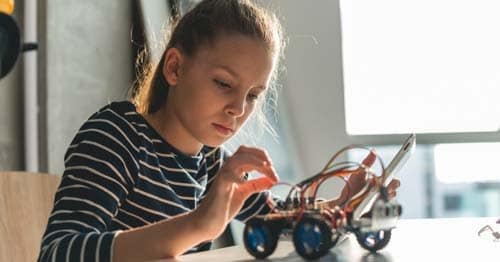Setting Healthy Screen Time Limits for Students Learning Online
by Julie Hersum
byBob Engler
5 min to readWhen you and your student start thinking about creating a welcoming, inspiring area for their online studies, keep this adage in mind: A place for everything, and everything in its place.
Your student will spend a lot of time there, and how it’s organized will have an impact on their attitude and comfort, both of which support the learning experience. An appealing, student-centric environment stokes kids’ enthusiasm every time they sit down and turn on the computer.
Putting together a space in which there is "a place for everything” begins with a checklist of what you’ll need:
You’ll come with more ideas for the list as you and your student plan it out. This stage is also a good time to remind your student to de-clutter the school at home setup regularly. Keeping “everything in its place” makes it easy to find things instead of rummaging around for them.
Workspaces do not organize or clean themselves. But taking a little time to keep everything in its place creates a positive, distraction-free environment so you can concentrate on learning.
Research has found that people who deal with constant, off-topic distractions often complete their tasks faster, but experience "more stress, higher frustration, time pressure and effort."

Preparing the space itself, whether a bedroom corner dedicated to schoolwork or a separate room, is every bit as important as deciding what goes in it.
Natural light and other sources of blue light increase productivity, improve mood, and support learning, according to research published by an interior-design engineering firm.
Keeping that in mind, position your student’s homeschool desk setup near a sunny window or in a room that gets plenty of natural light. If your home doesn’t have good exposure to the sun, blue-enriched LED lightbulbs are also effective.
Office design professionals recommend using LED lights for a variety of reasons:
Turn down direct lights or use diffused sources to reduce glare on computer screens and desktops. Supplement room lighting with desktop task lamps to properly illuminate books and papers.
Noise is the great distractor when trying to learn. It interrupts focus, engagement, and overall learning. Children are much more vulnerable to the impact of noise. Studies have demonstrated that the quieter the space, the better optimized it is for learning.
Having said that, certain types of background music can stimulate learning. It can improve memory, focus, and cognitive development while studying, as well as ease anxiety and boost the immune system.
A few tips on choosing the right music for your learning environment: use instrumentals— lyrics are distracting—and a diverse playlist set at a reasonable volume. There is one exception: punctuate the study soundtrack with some funky stuff to lighten the mood during breaks.
An important consideration in making a student-centric learning space is to give your student ownership in the design of the space. Letting them personalize the room will motivate them to use and care for it.
Another idea is to let them choose the paint. Color psychology asserts that orange promotes motivation, green is calming, yellow energizes, purple sparks creativity, and blue supports productivity.
If you have room, set up a maker space where your student can build projects that complement their STEM schoolwork. Stock with arts and crafts supplies, Legos, and kid-safe, age-appropriate tools and electronics, and turn them loose. Maker-space activities put students on a path to mastering critical life skills such as innovation, critical thinking, and creative problem-solving.

If you’re thinking that your student’s learning space should be spacious and solely dedicated to online studies, think again.
You may not need as much space as you think to organize a cozy, inspiring home classroom.
Think about setting up a couple of dedicated study spots. For instance, put the computer in one area and dedicate another to the work desk. In fact, they don’t even have to be “rooms.” A spot under a lofted bed or a closet big enough to accommodate a desk.
Be creative when looking for ways to organize a classroom in a limited space.
Once you’ve finished your child’s homeschool setup, it’s time to review what’s on your back-to-school shopping list in preparation for the first day of virtual school.
Check out more ideas for helping kids start their online learning adventures successfully by visiting the Connections Academy’s resources page.
